GW-150: Sniper Rifle for P-26
Required translator preface
History GW-150 rifles are inextricably linked with the so-called “Organization P-26” (Organization P-26) - a secret organization that existed in Switzerland during the Cold War. The foundation year is 1979. Switzerland, located in the heart of Europe, in the event of a cold war escalating into a “hot” one, would be in the “center of the hurricane” and probably would have been occupied by one of the belligerents. In this case, members of the organization were supposed to start a guerrilla war. For this, stocks were created. weapons, ammunition, explosives, and caches. P-26 was organized by the General Staff of the Armed Forces of Switzerland with the knowledge of Parliament. Members of the organization are active and retired military and security forces, reservists. Armament and other property was provided by the Armed Forces and in peacetime was stored in army warehouses. In 1989, information about the P-26 was leaked to the media. A scandal broke out. The left parties accused the government of creating a “secret army” to crush the opposition. P-26 has been banned and dissolved.
The details of the creation and activities of the P-26 Organization are still shrouded in secrecy. The study of this topic is devoted to the book by Martin Matter "П-26: the secret army, which was not such" (Martin Matter „P-26, die Geheimarmee, die keine war“). This book is described in the article by the Swiss Weapons Magazine (Schweizer Waffen Magazin), 2012. No.7.
Those who speak German can read the article on Wikipedia (https://de.wikipedia.org/wiki/P-26). There are also options in English and French. [/ I]
All that concerns “Gewehr-150” (“Gever-150”, “Rifle-150”), developed and manufactured in negligible quantities by SIG in Neuhausen, is secret and is known only to a few specialists. The author only by chance came across one museum specimen and had the opportunity to photograph it. Alas, it was not possible to try on the shooting range.
Some remarks: in the article we will consider only the technical aspects of the “Gewehr-150” - an interesting sample of the Cold War times. Military and political issues are deliberately set aside. In addition, the majority of people associated with the development of these weapons, as well as with the activities of the P-26 group itself, do not want to open to the public or are still obliged to keep secrets. Therefore, the article does not mention real names. Those who wish to learn more about the P-26 group can be advised by Martin Matter's book P-26: a secret army that has not been such (Martin Matter P-26, die Geheimarmee, die keine war). The book GW-150 is mentioned only once, without any details, which we will try, as far as possible, to reveal in this article. Many of the technical details mentioned are based more on conjectures that cannot be confirmed or refuted.
At first there was a technical task
From the illustrations for the book “П-26: the secret army, which was not such”, it is clear for what purposes various types of weapons were supposed. Pistols (Zig-Sauer R-250) - for self-defense, as well as machine guns HK MP-5 with a silencer, the barrels of which, apparently, were drilled in order not to depend on the presence of special subsonic cartridges. The cumulative grenades repeatedly mentioned in the book served rather for breaking into armored doors than for anti-tank defense.
Since the submachine guns were effective at distances up to 50, at best up to 100 meters, a special rifle was needed with which an experienced shooter could hit targets the size of a beer can lid at distances up to 200 meters. The rifle was supposed to be "silent" and have enough power to activate (for example) disruptive charges. (These are such charges, which are installed in vulnerable places of any objects, and then are undermined from a distance by means of an accurate shot). It was also required for the elimination of time, destruction of technical means of protection, for example, video cameras, and so on. But, as already mentioned, it is rather speculation.
The main requirement was shooting accuracy at 200 meters, and since such a weapon did not exist at that time, it had to be designed specifically for the needs of the “P-26 group”, as well as the cartridge.
Readers of our magazine probably remember an article about the DeLisle carbine. This weapon from the times of the Second World War, which is an Enfield rifle, equipped with a silencer and firing .45ACP cartridges, was effective at distances up to 100 meters.
The then EMD (now VBS) (Defense Department. - Approx. translator) sent the terms of reference to the company ZiG in Neuhausen, where systems for firing heavy subsonic bullets were developed, but there was no experience in developing silencers. For this, a third-party specialist was involved, whom we call N.N. Whether the idea of the special cartridge belongs to him, or to anyone else, is unknown, since N.N. left for a long time to retire and refused to contact the author. Upon completion of the work, he, as he was ordered, destroyed all the design documentation.
Special cartridge "Super Magnum"
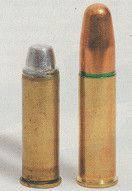
The .41 Magnum cartridge with a lead bullet next to the special rifle cartridge 10,4 mm. for the GW-150. Used sleeve - .41Magnum
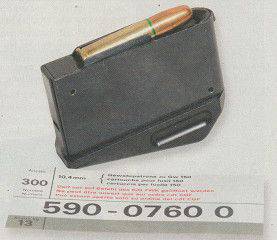
Shop on the 3 cartridge, below the factory sticker label for cartridge packaging on the 300 pieces. Both are extremely rare these days.
The .45ACP cartridges available at the time and the subsonic version of the .308 Win. did not meet the requirements. 300 Whisper then existed, and its efficiency is no higher than .308 Win. Consequently, a new cartridge with a relatively short sleeve was required, which would provide a heavy bullet with a speed of at least 315 m / s. The task was assigned to a cartridge factory in Thun. All information is also kept secret, but real samples are known that are of considerable (historical) interest. The sleeve was used from .41 Magnum (Remington), the bullet is most likely special, weighing approx. 410 Gran. Thus, at a distance of 200 meters, it saves energy over 1000 J - more than that of .308 Win Subsonic or .300 Whisper.
The trajectory of the bullet. nevertheless, it is very steep with a rifle, adjusted to 100 meters, at a distance of 200 m the point of impact turns on 110 cm below the aiming point. It is clear that under these conditions an accurate estimate of the distance is very important. The presence of any special device for this is unknown.
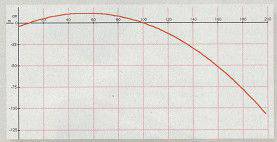
A very steep trajectory suggests that accurate distance estimation is very important for shooting at distances greater than 100 meters.
"SiG Sauer" and "body kit"
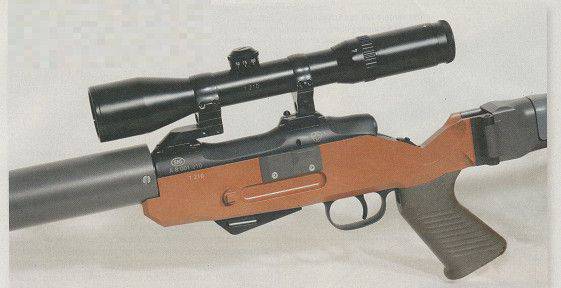
On the left side of the receiver is visible markings of the army sample and the Swiss coat of arms. Also visible is the screw that holds the muffler to the barrel.
The hunting rifle “SiG Sauer” was used as a basis (at that time the company was also called “Sauer und Sohn”). Folding stock and pistol grip taken from the prototype Stgw 90. Aluminum box and muffler are made specially. The dimensions of the silencer allow us to judge its high qualities. Optical sight without modification. The multiplicity of 4-6, produced by Schmidt + Bender. For shooting at a distance of 50-200 meters, it is quite suitable. EAW's massive bracket seems to say that in those days they did not spare the defense money ...
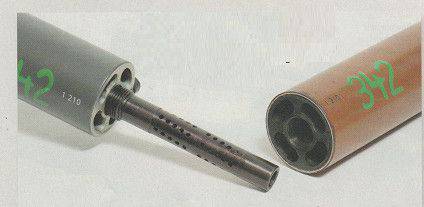
The front of the muffler is attached to the thread and removed for cleaning. You can see the internal structure of the muffler and the additional drill hole
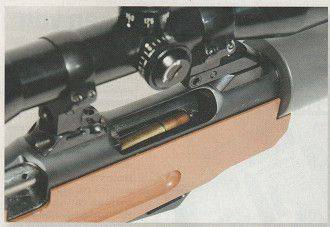
View of the top cartridge triple store through the eye of the release. Optical sight Schmidt + Bender special manufacturing
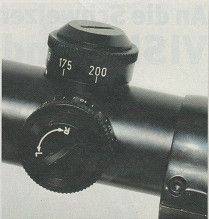
Sight installations are limited by distances from 50 to 200 meters. No additional distance measuring devices are provided.
The large size of the silencer allows us to judge its high acoustic qualities, but it is not necessary to speak about complete silence
Technical data:
Model: GW-150.
Type: Tilt Rifle.
Manufacturer: SiG Sauer (presumably).
Caliber: special cartridge 10,4х32.
Barrel length: 350 mm.
Scope: optical 4-6х42 mm.
Magazine capacity: Cartridge 3.
Fuse type: slide on the neck of the stock.
Overall length: 1155 mm. 895 mm - with folded butt.
Weight: 5,85 kg.


Information